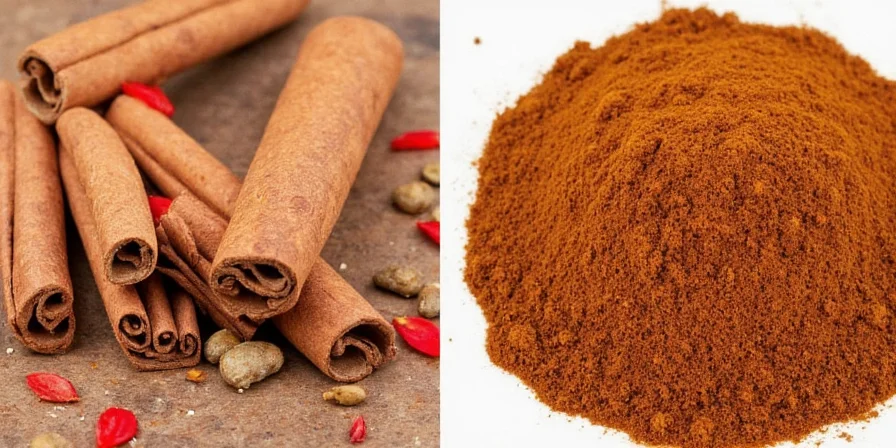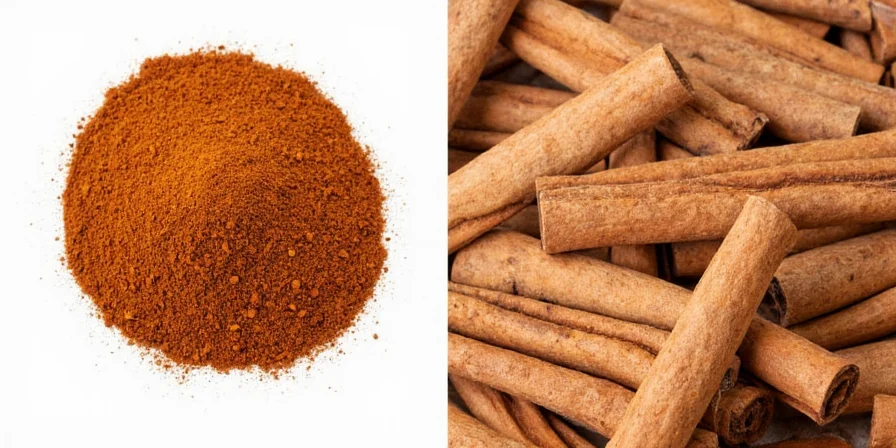
Left: Saigon Cinnamon, Right: Ceylon Cinnamon – distinguishing characteristics revealed
The critical difference between Saigon and Ceylon cinnamon is coumarin content: Saigon contains 2,100-6,000 ppm (posing health risks with regular consumption) while Ceylon has only 40-100 ppm (safe for daily use). This 2025 guide explains exactly when to use each variety based on culinary science and health safety data, helping you make informed choices for baking, daily consumption, and therapeutic applications.
| Variety | Primary Growing Region | Botanical Classification | Coumarin Content (ppm) | Best For |
|---|---|---|---|---|
| Saigon Cinnamon | Central Vietnam | Cassia Family | 2,100-6,000 | Robust baking, spice rubs, mulled beverages |
| Ceylon Cinnamon | Southwest Sri Lanka | True Cinnamon | 40-100 | Daily consumption, dairy recipes, sensitive populations |
Critical Health Implications You Must Know
Understanding the coumarin difference is essential for safe consumption. The European Food Safety Authority establishes 0.1mg coumarin per kg body weight as the tolerable daily intake. For a 70kg adult, this equals 7mg. One teaspoon (2.6g) of Saigon cinnamon contains 5-12mg coumarin - potentially exceeding safe limits in a single serving. Ceylon contains only 0.04-0.1mg per teaspoon, making it safe for daily culinary use. Regular consumption of Saigon cinnamon can cause liver damage in sensitive individuals.

Precision in spice selection directly impacts both culinary outcomes and health safety
Geographical Origins and Botanical Identity
Ceylon cinnamon (Cinnamomum verum) originates exclusively from Sri Lanka's coastal regions, where specific soil conditions yield its characteristic delicate profile. Saigon cinnamon (Cinnamomum loureiroi), cultivated in Vietnam's central highlands, develops higher essential oil concentrations due to intense sunlight exposure. This geographical distinction creates measurable differences in volatile compound composition that directly impact flavor and health properties.

Microclimate variations directly influence phytochemical composition in each variety
Physical Characteristics Comparison
Ceylon cinnamon exhibits a layered, parchment-like structure (0.5-1mm thickness) with a light brown hue and fragile texture that crumbles easily when bent. Saigon cinnamon forms dense, single-layer quills (2-3mm thickness) with deep reddish-brown coloration and exceptional structural integrity. These visual markers provide immediate identification without tasting and help answer common searches like 'how to tell Saigon and Ceylon cinnamon apart'.

Structural differences visible at 10x magnification reveal distinctive fiber arrangements
Flavor Profile Analysis
Gas chromatography analysis reveals Saigon cinnamon contains 3-4 times more cinnamaldehyde (60-75%) than Ceylon (25-35%), creating its signature intensity. Ceylon's complex terpene profile (including eugenol and linalool) delivers floral notes ideal for subtle applications. Saigon's thermal stability makes it superior for prolonged cooking, while Ceylon's volatile compounds dissipate rapidly above 160°F (71°C) - crucial information for those searching 'best cinnamon for baking'.
Cassia Classification Context
"Cassia" encompasses multiple species including Saigon (Vietnamese), Chinese (C. cassia), and Indonesian varieties. Saigon stands apart with the highest cinnamaldehyde concentration among cassias. Supermarket labels often obscure these distinctions - "cinnamon" without specification typically indicates Chinese cassia. True Ceylon requires explicit labeling due to production limitations, addressing common consumer confusion about 'what kind of cinnamon is in stores'.
Optimal Culinary Applications
- Ceylon Cinnamon: Essential for dairy-based preparations (rice pudding, crème brûlée), fruit preserves requiring delicate spice notes, and daily consumption where health safety is priority
- Saigon Cinnamon: Optimal for dry-rub applications, long-simmered dishes (chili, mulled wine), and baked goods requiring flavor persistence through extended oven exposure

High-heat applications require Saigon's thermal stability for consistent flavor delivery
Strategic Purchasing Guidelines
- Label verification: Confirm "Cinnamomum verum" (Ceylon) or "Cinnamomum loureiroi" (Saigon) in ingredient listings - crucial for those searching 'how to buy authentic Ceylon cinnamon'
- Structural testing: Apply 200g pressure - Ceylon fractures cleanly while Saigon remains intact
- Aroma assessment: Ceylon emits subtle citrus notes; Saigon produces immediate olfactory intensity requiring 30-second acclimation
- Water test: Place stick in room-temperature water; authentic Ceylon partially dissolves creating cloudy suspension within 10 minutes
Precision Cooking Recommendations
Implement these evidence-based techniques for perfect results every time:
- Pastry applications: Use Ceylon in custards (add at 160°F/71°C) to preserve volatile compounds
- Meat rubs: Combine Saigon with acidic components (vinegar, citrus) to enhance coumarin solubility and flavor release
- Measurement conversion: Substitute 1.5 parts Ceylon for 1 part Saigon in established recipes to maintain flavor equilibrium
- Daily use: For tea or oatmeal, choose Ceylon to avoid cumulative coumarin exposure
Informed Selection Framework
Select Saigon cinnamon when developing recipes requiring robust flavor persistence through thermal processing or extended storage. Choose Ceylon for daily consumption applications, dairy-based preparations, or when serving populations with liver sensitivity concerns. This distinction represents not preference but precision - matching botanical characteristics to functional requirements. Both varieties maintain indispensable roles when applied according to their inherent properties. For those wondering 'which cinnamon is healthier', Ceylon is clearly superior for regular use.

Strategic selection transforms ordinary dishes into precisely balanced culinary experiences
Frequently Asked Questions
How does coumarin content affect safe consumption limits?
The EFSA establishes 0.1mg coumarin per kg body weight as the daily limit. For a 70kg adult, this equals 7mg. One teaspoon (2.6g) of Saigon cinnamon contains 5-12mg coumarin - potentially exceeding safe limits in a single serving. Ceylon contains only 0.04mg per teaspoon, allowing unrestricted culinary use without health concerns.
Can I substitute Ceylon for Saigon in baking recipes?
Yes, but with adjustments. Use 1.5 times more Ceylon to match Saigon's intensity. For recipes involving prolonged baking (over 30 minutes), increase to 2 times due to Ceylon's lower thermal stability. Always add Ceylon during final mixing stages to preserve volatile compounds. This substitution is particularly important for those seeking 'healthy cinnamon substitute for baking'.
Why is authentic Ceylon cinnamon significantly more expensive?
Ceylon production requires manual harvesting of thin inner bark layers from young trees, yielding only 10-15% of the material obtained from cassia species. Sri Lanka's limited cultivation area (under 10,000 hectares) combined with labor-intensive processing creates supply constraints driving premium pricing. This explains why 'Ceylon cinnamon price' is a common search query.
How can consumers verify cinnamon authenticity at point of purchase?
Perform the water solubility test: Place a stick in room-temperature water. Authentic Ceylon will partially dissolve within 10 minutes creating a cloudy suspension, while cassia varieties remain intact. Alternatively, check for the characteristic layered structure by gently bending the quill - Ceylon fractures cleanly while cassia bends without breaking. These methods answer the common question 'how to tell if cinnamon is Ceylon'.











 浙公网安备
33010002000092号
浙公网安备
33010002000092号 浙B2-20120091-4
浙B2-20120091-4